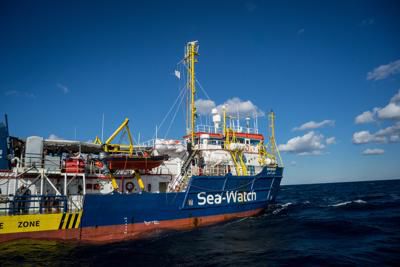Lampedusa: „I prayed for the whole journey“, says the doctor aboard of the speedboat
La Repubblica, by Raffaella Cosentino – During the crossing, of which the return has lasted more than 17 hours, the rescue workers also feared for their lives and even the most experienced have not felt comfortable. “We no longer had enough blankets; the wind had blown them away. Some crawled into to the engine room to warm up and we had to interrupt the journey.” This is the dramatic testimony of Gabriella Lattuca who is part of the Italian rescue team which is under the command of the Maltese Navy.
LAMPEDUSA – Gabriella Lattuca, a doctor from Agrigento embarked for the first time with CISOM (the Italian rescue team of the Order of Malta) on the speedboat of the Italian coast guard. For her, the rescue of 58 migrants close to the Libyan coast, half of whom arrived dead at the port of Lampedusa, was a baptism of fire in the middle of very high waves. Three speedboats departed from Lampedusa of which two have been taken on board the castaways. On board of each speedboat were eight rescue workers, i. e. six crew members including the captain, a doctor and a medical assistant. On both search and rescue boats (SaR), there was a doctor on board.
The dramatic report of the doctor Gabriella Lattuca: All victims were on board of the speedboat on which Gabriella Lattuca was staying. “You start to realize that you are a human too, whether you are a doctor, a medical assistant or a diver. The nature exceeds our abilities and skills. We put all our courage, our will and our love in. I have seen the operation as a mission. This is why I became a doctor. I have chosen to rescue migrants out of charity. But I feared for our lives and I do not want to hide the fact that I prayed from the beginning to the end of the journey.”
The patrol boats SaR left Lampedusa two days ago at 4 pm. They reached the boat in distress at 10 pm. At 10:45 pm, the return started, slowing down due to bad weather conditions. Yesterday afternoon at 4:30 pm, the boats entered the port of Lampedusa. The outward journey took six hours, whereas the return more than 17 hours.
Waves up to 8 meters high. “It rained and hailed. The waves were up to 8 meters high and the wind was very strong. The extremely adverse weather conditions have made the mission very difficult for us and for the whole crew,” says Lattucca. “For the migrants who already had one and a half days at sea, the situation was, of course, more difficult. Some have confided to me that they had not eaten for weeks. Many were suffering from hyperthermia.” Not only the migrants felt uneasy but also the experienced rescue teams. No one had ever seen such a restless sea. The doctor of CISOM continues: “On the way back we drove very slowly and there were some incidents. The crew was not doing well, either, and we had to help them. I myself also suffered from the heavy seas. “
The limits of the rescue operations at sea. The sea rescue with patrol boats is also limited as these boats can take very little on board. Lattuca explains: “We don’t have the equipment for 60 people on board. Although we have distributed thermal blankets, they were not enough for everybody because they were blown away during the crossing due to the strong wind. We gave new blankets to the migrants and they were blown away again.” Another tool are the heating bags, explains the doctor from Agrigento. A bag containing liquid that warms up when punching hard. But even that was not enough, as well as the attempt to bring by turns some people in the covered area of the speedboat. At the rear, they died from the cold. Gabriella Lattuca continues: “Suddenly the fire alarm went off and it smelled like something had caught fire, but no fire broke out. The ship engineer went to have a look and noticed that some migrants had tried to enter the engine room, where the barrels with the fuel are, to protect themselves from the cold.” It was hard to keep track of the situation outside and even that a few people died remained unnoticed at first. We have noticed the dead at the stern when the diver made his round, but by then, it was too late. We did not notice the death of the others until the end.” The only one who could intervene in these dangerous circumstances was the diver of the crew. He is equipped in a certain way that he can walk the SaR boat sideways, because he has a safety harness and is equipped in case of falling into the sea.
It was impossible to alert help from the air. “The diver went to take a look. It is a courageous and hard job. Even he himself was not feeling well but he was still able to react”, said the doctor. Due to the weather conditions and because of the high number of people who were in critical condition, it was not possible to request rescue teams from the air. “This was my first assignment on a sea rescue speedboat,” concludes the doctor who used to work at the reception centre of Lampedusa in 2013. “My more experienced colleagues have told me that they have never seen such a sea.” As it was already the case with similar dramatic incidents, a team of psychologists from CISOM came to Lampedusa to offer their help to the rescue workers of the Italian coast guard, the doctors and medical assistants of the rescue team (under Maltese command) and to all the others.
“We saved 75 people from death,” confirms Mauro Casinghini, National Director of CISOM. “You can argue and criticise a lot, but if you set out at sea state 8 with a patrol boat to save a boat filled only half with air and already half-sunken, which is located about 100 miles away, the likelihood that you cannot find a soul is greater than saving some lives.”
Translation: Aylin Satmaz


